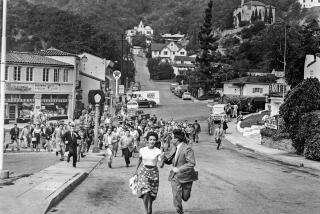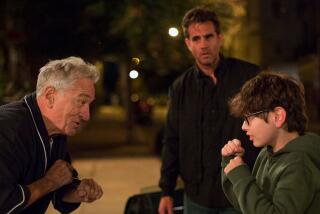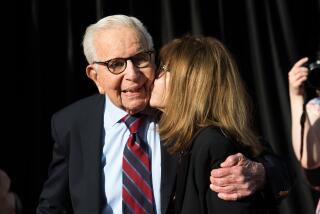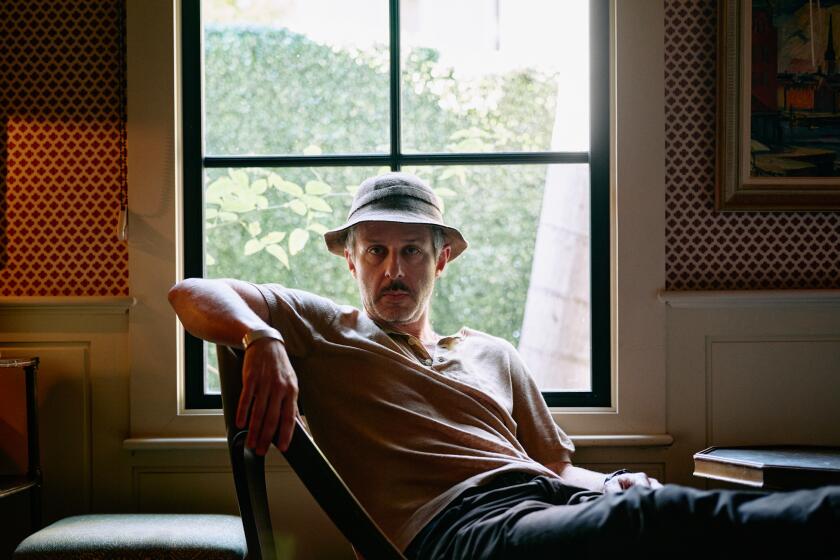His risk and reward
Emile HIRSCH woke up at the edge of his bed after weeks of filming “Into the Wild,” shouting into what he thought was the Grand Canyon, convinced that director Sean Penn and his crew had abandoned him to test his endurance.
“Sean’s really pushing me now,” he thought. “How could they do this to me?”
Even after he registered the blank hotel room walls around him, Hirsch wasn’t sure what town he was in. The months-long shoot had taken them to dozens of locations from Mexico to Alaska. It was all starting to wear on him.
But it wasn’t like Penn didn’t warn him. As Hirsch recalled it, Penn was visibly relieved when he accepted the part. “You’re a good guy,” Penn told him. “You’ve got a good head on your shoulders. . . . I’d feel bad about what I was going to put you through if you were really tortured at the get-go.”
“Into the Wild,” which opened Friday, set a new threshold for Hirsch. He dropped a quarter of his body weight for the part of real-life adventurer Christopher McCandless, who in 1990 set out alone on a two-year cross-country trek, eventually heading for the Alaskan wilderness only to starve to death four months after he got there. Hirsch ran 20 miles a week. He canoed river rapids. He came face-to-fangs with a grizzly, take after take. He carried a 30-pound pack much of each day. Even in waist-deep snow. And he joined the small crew in a weeklong campout on the Colorado River -- macho stuff for an actor whose most daring on-screen challenge up to that point had been shaving his head for “Lords of Dogtown.” And as that film’s director, Catherine Hardwicke, remembered it, even that took some serious coaxing.
But Hirsch said he was so pumped up while filming “Into the Wild” that the physical exhaustion, the fact that he was working for one of his idols, the fact that the role could launch him as a leading man, didn’t really get to him. He just felt lucky.
“I believed in what I was doing so much that I was never really nervous in ways that I’ve been on other projects,” he said. “I was always like, ‘Wow. I can’t believe [Penn] hired me.’ ”
Indeed, Penn had envisioned Leonardo DiCaprio in the part 10 years ago, when he first read the book. But by the time he got the movie rights, DiCaprio was too old for the role. Hirsch, however, was just the right age. “On the cusp of going from boy to man,” Penn said.
At the time, Hirsch had finished “Dogtown,” a feature inspired by the 2001 skateboarding documentary “Dogtown and Z-Boys.” Penn was so moved by Hirsch’s performance as the brooding but sensitive skateboard pioneer Jay Adams that after Hardwicke screened “Dogtown” for him, he wanted a meeting.
“I got him on the cellphone and just handed it to Sean,” said Hardwicke, who stayed close with Hirsch after their film wrapped. “It was a dream come true for Emile.”
Months passed. Penn invited Hirsch to dinner, and over time they got to know each other.
“I didn’t really know it was an audition process the whole time,” said Hirsch. “I kind of just thought maybe, four years from now, gosh, maybe it could happen. He literally called me out of the blue one day and said, ‘I just finished the script and the part is yours if you want it.’ ”
Ascending
All that seemed like a lifetime ago as Hirsch recalled it, sitting poolside at the Viceroy Hotel in Santa Monica on Labor Day, surrounded by tan vacationers. He looked a bit goth with the jet-black hair and pale complexion of Speed, the earnest race car driver he plays in the Wachowski brothers’ live-action version of the 1960s anime “Speed Racer,” set for release in May. He’d wrapped the film in Berlin just two days earlier.
“I didn’t have one scene outside,” he said, leaning dramatically into a bar of sunlight. “I must be so pale.”
Until now, Hirsch has appeared in small but critically appreciated films like “Dogtown” and “The Dangerous Lives of Altar Boys.” He’s still so anonymous that the hotel staff bumped him three times from his cabana to make room for other guests. This time next year, that’s not likely to happen.
“Into the Wild” and Hirsch, specifically, have already earned high praise and Oscar buzz coming out of the Toronto Film Festival. And “Speed Racer” will no doubt mark Hirsch’s coronation. It’s a heady time for the 22-year-old, but he said he’s prepared for whatever comes.
“I think I’ll just stay pretty similar to how I have been,” he said. “Pretty mellow, you know?”
Hirsch grew up in Los Angeles and Santa Fe, N.M., and started acting at age 8. By 14, he was regularly landing small parts on TV. His first film role was the lead opposite Kieran Culkin and Jena Malone in 2002’s “Altar Boys,” a coming-of-age tale that starred and was produced by Jodie Foster. He went on to star in a handful of others while still in high school, often opposite the likes of Kevin Kline and Sigourney Weaver.
But if those movies represented Hirsch’s undergraduate years, making “Into the Wild” was like earning a doctorate. To prepare, Hirsch pored over McCandless’ tersely written journals looking for clues. He read some of McCandless’ literary idols, like Henry David Thoreau and Jack London. He visited McCandless’ parents and spent a few days with his sister.
He also trained and dieted relentlessly. He got so thin, Hardwicke said, that she seriously suggested he talk to Christian Bale -- who became emaciated for “The Machinist” -- about staying healthy.
For all that research, though, Hirsch ultimately found McCandless enigmatic, a personality that still puzzles him.
“He’s a guy who doesn’t show a lot to anybody,” Hirsch said. “Even to himself. He’s happy and he’s merry, but he’s not a guy who’s going to sit there and tell you his life story.”
McCandless grew up in Virginia with affluent and attentive parents. But after he graduated from Emory University, he gave away his $24,000 in savings to charity, abandoned his car, went by the name Alexander Supertramp and hitchhiked around the country and then up the coast to Alaska, telling his family virtually nothing.
There, he spent more than 100 days living in an abandoned bus in the brush. When he ran out of food and decided to leave, McCandless found the river too swollen to pass. Desperate and ravenous, he mistakenly ate some wild plants that he soon realized inhibited his body from absorbing nutrition and he died of starvation.
Creating that moment on film, when he knows his fate is sealed, was one of the toughest for Hirsch. Throughout the shoot, Penn had encouraged him to preserve his analytical mind but never second-guess his instincts. After Hirsch had done one take and wasn’t satisfied, Penn approached him with a thought.
“You know, this is your life,” Penn told Hirsch. “I can’t tell you what to do here. This is your life.’ ”
“Then he walked off,” Hirsch said. “It was just an amazing moment. How can you tell someone how to react when you find out you’re going to die like that? He wanted it to be so personal and real. He just gave it to me.”
--
More to Read
Only good movies
Get the Indie Focus newsletter, Mark Olsen's weekly guide to the world of cinema.
You may occasionally receive promotional content from the Los Angeles Times.










